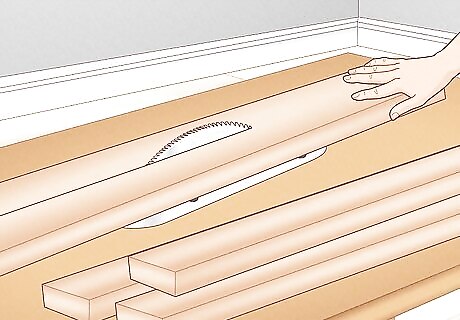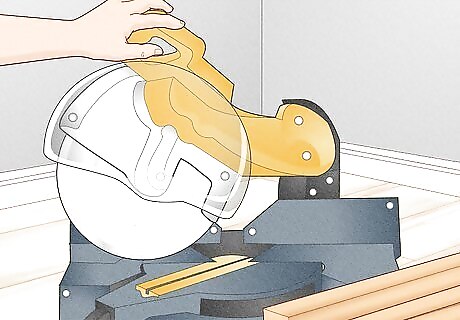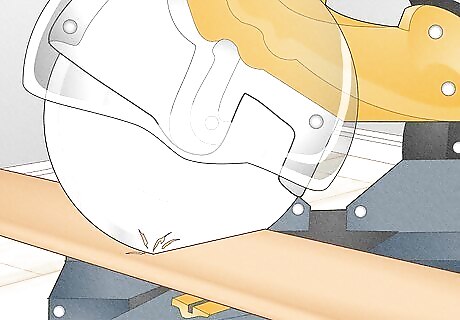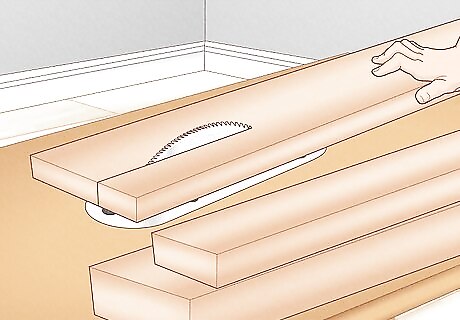
views
- Table saws are better suited to cutting large pieces of wood, but are a bit more dangerous.
- Miter saws excel at precise, smaller cuts, and are more portable and safer.
- Choose a table saw for general, versatile use in a number of projects, or for projects that require larger cuts.
- Choose a miter saw for a beginner-friendly option for use on smaller projects.
What is a table saw?

A table saw is a circular blade that emerges upward from a platform. The surface, or table, supports the length of wood as you push the wood across the circular blade. The motor and other mechanics are all stored beneath the table, and the blade can be raised, lowered, or exchanged for an alternate blade. On some table saws, the angle of the blade can also be adjusted to change the angle of the cut. Since table saws are affixed to a table, they’re typically less portable. That said, some table saws are built on movable carts or smaller, more portable tables.
Table Saw Uses

Table saws are ideal for basic cuts on large amounts of wood. Using a table saw is ideal for simple, general cuts, like rip cuts (cutting parallel to the grain), cross cuts (perpendicular to the grain), or basic angled cuts. They’re also perfect for cutting high volumes of wood, whether that means making many similar cuts on many planks, or cutting through larger, denser planks. With the addition of a miter gauge and other accessories, a table saw can also competently execute more intricate cuts, though they’re generally less precise than a miter saw. Many table saws can also cut through some metals and other materials, but this capability varies by model.
What is a miter saw?

A miter saw features a circular blade affixed to a moveable arm. The blade can be swiveled and lowered onto a length of wood that rests on a sawhorse or miter saw table, which isn’t attached to the arm or blade. They’re typically more portable than a table saw, making them advantageous for traveling woodworkers. Note that table saws and miter saws often have interchangeable blades that will work on either machine.
Miter Saw Uses

Miter saws are ideal for precise or more technical cuts. Since the blade can be manipulated on its arm, it’s best to use a miter saw to achieve more accurate, precise cuts like trims or bevels. And with a few adjustments of the arm, it can also make trickier angled cuts you may not be able to achieve with a table saw. Without repositioning, a miter saw can only make cuts as large as the diameter of the blade, since the blade moves through the wood, rather than the wood moving across the blade, like with a table saw. This makes miter saws less ideal for large cuts or rip cuts.
Costs and Safety Concerns

Table saws are typically more expensive than miter saws. The hardware and precision metalworking involved in manufacturing a table saw makes them a bit pricier, with a basic table saw running you anywhere from $300-$600. Larger or more powerful table saws for permanent placement in a woodshop can cost thousands of dollars. A basic miter saw costs about $200-$350, making them a bit more accessible for beginner woodworkers. As with table saws, a larger, more powerful, or more complex miter saw will quickly increase in price, costing nearly $1000 or more.

Miter saws are generally safer to use than table saws. The downward orientation of both a miter saw’s blade and arm movement make for much safer use, since the blade comes down to meet the wood, rather than the user pushing the wood toward the blade, along with their hands and fingers. In the event of a mishap, any kicked wood will be propelled away from you, unlike a table saw. In addition, most miter saws include a blade cover that shields you from the blade in most contexts, save for when you’re actively making a cut. Table saws come with the risk of “kickback,” which is when the wood catches on the side of the blade, propelling the wood back toward the user. It’s a problem you can avoid with proper handling and precaution, but it’s something to be aware of. The blade of a table saw is also more exposed during use, making for a more prominent and consistent safety hazard users must navigate around.
Which should you buy?

Purchase a table saw for more general-purpose woodworking. Technically, a table saw can do everything a miter saw can, it just might take a little learning and finessing on your part (plus added accessories). Its versatility will allow you to complete a wide range of projects using the table saw as your primary tool. Opt for a table saw if your project involves a lot of: Ripping raw lumber Cross cuts Cutting flat sheets of wood Building large furniture or cabinets

Opt for a miter saw if you’re a beginner, or need smaller, precise cuts. Beginners most likely won’t need the power and scale of a table saw, and the added safety makes them perfect for someone still learning the ropes. Their lower cost of a miter saw also makes it an easier buy for novices. Go for the miter saw if your project involves more: New construction (framework, remodeling) Precise trimming Generally smaller pieces of wood Cutting longer planks
















Comments
0 comment